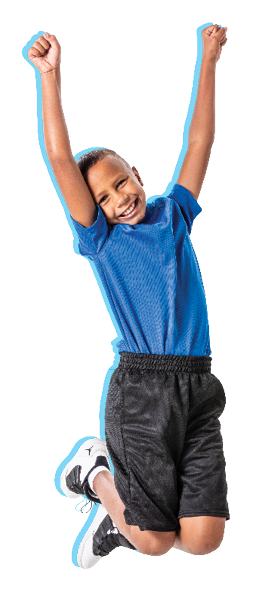National Nutrition Month® is a nutrition education and information campaign sponsored by the Academy of Nutrition and Dietetics. It focuses on the importance of making informed food choices and developing good eating and physical activity habits. National Nutrition Month® started in 1973 as National Nutrition Week, and it became a month-long observance in 1980 in response to growing interest in nutrition.
Some PE teachers have the opportunity to teach health classes along with their PE classes, others try to integrate nutrition concepts into their PE lessons as they do not have dedicated time to teach health. So, what can you do during National Nutrition Month to integrate nutrition into your classes? Below are 3 ideas to help you get started.
1. Change the Vocabulary of Your Own Activities
You can adapt your own lessons just by changing the terminology you use for the activity. For example, in the game Clean Your Backyard, the activity area is divided into 2 halves with a line down the middle. Half the class is on each side and teams try to throw fluffballs to the other side to “clean their backyard”. Instead of the backyard theme, you can change it to “clean your refrigerator” and tell them that all of the fluffballs are junk food and they want to get rid of all of the unhealthy food out of their fridge. You can also use the colors of beanbags, etc. to talk about the colors of certain fruits and vegetables. These activities allow you to reinforce nutrition terms with students, so they hear them in multiple places like from their classroom teachers, in PE class, the cafeteria, and at home.
2. Teach About Energy Balance
Physical education is the perfect place to teach students about energy balance. It is important for them to understand the energy in and energy out concept. Using a game called Calories Count we can teach students how to balance exercise with the food we put in our bodies. To set this up you put 4 hoops in the center of the activity area and scatter 1 cone per student around the activity area. Create calorie cards- cards with a food or drink and the number of calories they represent as well as how many cones need to be touched to “burn off” the calories. Place these cards face down in the 4 hoops. To play, groups are located around the perimeter and they send 1 group member to the center to collect 1 playing card, then return to their group. All group members read the card, then individually move to touch the number of cones listed on the card. Everyone moves at the same time, each touching the number of cones on the card. When finished, they return to their group spot and send someone new to collect another card from the center hoops. This game reinforces the concept of balancing energy and highlighting the need to exercise to use up the energy we put in our bodies through food and drink.
3. Teach a New Nutrition Concept or Behavior Modifications Strategy
In an activity called Fat Transfer, students will learn about cholesterol. Create a large, square activity area with a hula hoop in each corner (the hoops represent the blood vessels). Then divide the class into 4 even teams, one at each hoop, with 1 beanbag per student (represents HDL- high-density lipoprotein) and 1 foam ball per student (represents LDL- low-density lipoprotein) in their hoop. The object of the game is to remove all the LDLs (large balls) from your blood vessel (hoop) and fill it with HDLs (beanbags). Students do that by taking one of their LDLs and jogging to another hoop and leaving it there then picking up an HDL and taking it back to their blood vessel (hoop). This can help teach students about how cholesterol affects their body and the types of foods that raise and lower your cholesterol.
It’s important for youth to understand nutrition so they can become aware of their health and be motivated to incorporate healthy habits into their own daily lives. Physical education is the ideal opportunity for teaching students about nutrition and these 3 strategies can help you plan lessons to support nutrition education in your classes.








